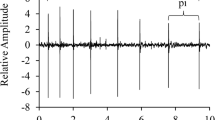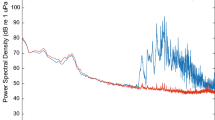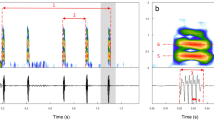Synopsis
During reproduction maleCottus bairdi defend cavities beneath stones and perform defense and reproductive displays. Using a geophone to detect substrate vibrations under dark conditions (infrared viewing), we recorded three types of sounds. ‘Knocks’ are produced during head nods and an acoustically similar sound is produced when the fish slaps the head to the substrate. A third sound, the ‘drum roll’ appears to be a fast repetition of several knocks followed by a head slap. We argue that these signals traveling through the substrate are of greater importance than sounds traveling through the water because (1) the substrate vibration attenuates at a much lesser rate than the water vibration and, (2) even near riffles, which generate much water vibration, the background noise in the substrate is low enough for the fish to detect such sounds.
Similar content being viewed by others
References cited
Anderson, C.S. 1983. The influence of stream size on sculpin population dynamics. Ph.D. Thesis, University of Michigan, Ann Arbor, 172 pp.
Barber, S.B. & W.H. Mowbray. 1956. Mechanism of sound production in the sculpin. Science 124: 219–220.
Bass, A.H. 1990. Sounds from the intertidal zone: vocalizing fish. Bioscience 40: 249–258.
Brown, L. & J.F. Downhower. 1983. Constraints on female choice in the mottled sculpin. pp. 39–54.In: S.K. Wasser (ed.)Social Behavior in Female Vertebrates, Academic Press, New York.
Coombs, S., R.R. Fay & J. Janssen. 1989. Hot-film anemometry for measuring lateral line stimuli. J. Acoust. Soc. Amer. 85: 2185–2193.
Coombs, S. & J. Janssen. 1990a. Behavioral and neurophysiological assessment of the lateral line sensitivity of the mottled sculpin (Cottus bairdi). J. Comp. Phys. 167: 557–567.
Coombs, S. & J. Janssen. 1990b. Water flow detection by the mechanosensory lateral line. pp. 89–123.In: W.C. Stebbins & M.A. Berkley (ed.) Comparative Perception-Volume II: Complex signals, John Wiley and Sons, New York.
Denton, E.J. & J. Gray 1983. Mechanical factors in the excitation of clupeid lateral lines. Proc. R. Soc. Lond. B 218: 1–26.
Dmitrieva T.M., P.L. Katsel, R.B. Valeyev, V.A. Ostroumov & Y.P. Kozlov. 1988. Purification of male sex pheromone of yellowfin sculpin Cottocomephorus grewingki. Biol. Nauka 6: 39–44. (In Russian).
Downhower, J.F. & L. Brown. 1980. Mate preferences of female mottled sculpins, Cottus bairdi. Anim. Behav. 28: 728–734.
Downhower, J.F., L. Brown, R. Pederson & G. Staples. 1983. Sexual selection and sexual dimorphism in mottled sculpins. Evolution 37: 96–103.
Enger, P.S. 1963. Single unit activity in the peripheral auditory system of a teleost fish. Acta. Physiol. Scand. 59 (Suppl 210): 4–48.
Fish, J.F. & G.C. Offutt. 1972. Hearing thresholds from toadfish, Opsanus tau, measured in the laboratory and field. J. Acoust. Soc. Amer. 51: 1276–1278.
Hawkins, A.D. 1981. The hearing abilities of fish. pp. 109–133.In: W.N. Tavolga, A.N. Popper & R.R. Fay (ed.) Hearing andSound Communication in Fishes, Springer-Verlag, New York.
Janssen, J. 1990. Localization of substrate vibrations by the mottled sculpin (Cottus bairdi). Copeia 1990: 349–350.
Jivoff P.R. 1986. Courtship Behavior of the mottled sculpin, Cottus bairdi. M.S. Thesis, Ohio State University, Columbus. 87. pp.
Kalmijn, A.J. 1988. Hydrodynamics and acoustic field detection. pp. 83–130.In: J. Atema, R.R. Fay, A.N. Popper & W.N. Tavologa (ed.) Sensory Biology of Aquatic Animals, Springer-Verlag, New York.
Ladich, F. 1989. Sound production by the river bullhead, Cottus gobio L. (Cottidae, Teleostei). J. Fish Biol. 35: 531–538.
Ladich, F. 1990. Vocalization during agonistic behaviour in Cottus gobio L. (Cottidae): an acoustic threat display. Ethology 84: 193–201.
Morris, D. 1954. The reproductive behavior of the river bullhead, Cottus gobio, with special reference to the fanning activity. behavior 7: 1–32.
Myrberg, A.A. & R.J. Riggio. 1985. Acoustically mediated individual recognition by a coral reef fish (Pomacentrus partitus). Anim. Behav. 33: 411–416.
Narins, P.M. 1990. Seismic communication in anuran amphibians. Bioscience 40: 268–274.
Popper, A.N., P.H. Rogers, W.M. Saidel & M. Cox, 1988. Role of the fish ear in sound processing. pp. 687–710.In: J. Atema, R.R. Fay, A.N. Popper & W.N. Tavolga (ed.) Sensory Biology of Aquatic Animals, Springer-Verlag, New York.
Savage, T. 1963. Reproductive behavior in the mottled sculpin, Cottus bairdi Girard. Copeia 1963: 317–325.
Tavolga, W.N. 1958. The significance of underwater sounds produced by males of the gobiid fish, Bathygobius soporator. Physiol. Zool. 31: 239–271.
Torricelli, P. & R. Romani. 1986. Sound production in the Italian freshwater goby, Padogobius martensi. Copeia 1986: 213–216.
Whang, A. 1992. Hydromechanical communication during reproductive behavior in three species of sculpin (Cottidae). M.S. Thesis, Loyola University of Chicago, Chicago. 54 pp.
Author information
Authors and Affiliations
Rights and permissions
About this article
Cite this article
Whang, A., Janssen, J. Sound production through the substrate during reproduction in the mottled sculpin,Cottus bairdi (Cottidae). Environ Biol Fish 40, 141–148 (1994). https://doi.org/10.1007/BF00002540
Received:
Accepted:
Issue Date:
DOI: https://doi.org/10.1007/BF00002540




